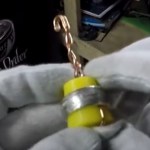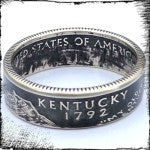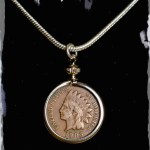Morgan Silver Dollar History - Get to know your Coin Ring

As promised, our first blog details the Morgan Silver Dollar history. This is by far our favorite coin ring and our best selling item in the shop. We hope you enjoy learning about this gorgeous coin!
The Morgan Silver Dollar
Designer: George T. Morgan
Composition: 90% silver, 10% copper
Weight: 26.73 grams
Diameter: 38.1mm (1.5 inches)
Edge: Reeded
The Early Years
In America's early years, the colonists used whatever coins they could find in circulation. As most of the settlers came from Europe, it was not surprising that English, Dutch, French, and German coins were commonly seen. However, the best-known and most widely used coin among the citizens turned out to be the Spanish Silver Dollar from the Mexico City Mint.
Then, in 1783, Thomas Jefferson proposed a different coinage for the United States that was based on the Spanish Silver Dollar and divided into 100 cents. When Congress met on July 6, 1785, to adopt a standard monetary unit, Jefferson's suggestions were accepted.
To determine the amount of silver to put into the new United States Silver Dollar, Alexander Hamilton weighed a group of Spanish Silver Dollars. According to legend, he used worn circulated coins that lost some of their silver content. Thus, the weight of a newly-minted U.S. Silver Dollar compared to the weight of a worn down Spanish one - 26.96 grams versus the Spanish 27.07 grams.
Until the Mint Act of April 2, 1792, though, it was not possible for the United States to strike its coinage. This Act was primarily important in the history of the United States because it established the U.S. Mint in Philadelphia and specified the Silver Dollar as the highest-denomination silver coin.
The U.S. Mint struck the first U.S. Silver Dollars in 1794, but American merchants kept the heavier and more valuable Spanish coins for themselves and exported the lighter U.S. coins to Europe for trade. As a result, U.S. coins disappeared almost as fast as the minting process. For this reason, Silver Dollar coinage ceased in 1804.
In 1836, Congress re-established the Silver Dollar (with a slightly lighter weight of 26.73 grams), and by the 1840s, they were being issued for general circulation once again. Even at this time, most Americans rarely saw a Silver Dollar in circulation, because most were held in bank vaults, exported, or melted for their precious silver bullion. This situation led to the Act of 1873 which eliminated the Silver Dollar from regular U.S. coinage altogether.
Comstock Lode largest silver strike in history
Around 1859, prospectors found a large silver vein near Virginia City, Nevada; this turned out to be the biggest silver strike in world history.
It was incredibly difficult to mine gold in this region because of "that infernal blue stuff," a rich blue clay that impeded mining efforts. Savvy miners reasoned there had to be a reason why the clay was blue, so they took samples to San Francisco for testing. The results showed that this clay contained some of the purest silver ever found.
At first, only a scant few knew about the clay. They vowed to keep it a secret. True to human nature, this did not occur. Within days, tens of thousands of miners were flocking to the area, and everyone was staking a claim.
Even Samuel Clemens, aka Mark Twain, said he staked a claim. His story is that he and three partners spent six months in a cabin drinking, playing cards, digging and panning. They found a rich vein of silver, and he spent ten days dreaming of what it would be like being a multi-millionaire. At that time, work on a new claim needed to start within ten days. During this period he was called away to visit a sick friend. He thought the partners were working at the strike, but that was not the case. In the end, someone else had staked claim to their find.
The Coinage Act of 1873
At the time of the Coinage Act of 1873, silver values were decreasing. Many factors - including the massive Comstock Lode and a flood of German silver into the market - contributed to this devaluation. The bill passed in Congress, and the production of silver coinage in the U.S. ceased. This occurred because of the large difference in value between gold and silver.
Bland-Allison Act
Written by Representative Richard P. Bland, The Bland-Allison Act contained amendments made to it by Senator William B. Allison. Congress passed it in February of 1878. This act restored silver as legal tender. It also included verbiage stating that the government would mint 2 million silver dollars per month.
Almost Half the Mintage Melted
Morgan Silver Dollars were minted continuously from 1878 until 1904. By the early 1900s, the Comstock Lode was exhausted, and the silver bullion supply ran out. As far as Morgan and the rest of the nation were concerned, the era of the Silver Dollar had come to an end. By this time, most Americans preferred to use paper money instead of carrying around heavy Silver Dollars. In fact, Silver Dollars circulated widely only in the sparsely-populated West, but in the rest of the country, banks and U.S. Treasury Department vaults stockpiled the coins.
In 1918, Congress passed the Pittman Act to replenish the government's reserves of silver bullion by officially melting millions of the Morgan Silver Dollars stored in Treasury vaults. As a result, over 270,000,000 Morgan Silver Dollars were melted - almost half the entire mintage from 1878-1904.
The Pittman Act also required the government to purchase more silver to replace the melted coins, so the Morgan Silver Dollar was briefly revived one more time in 1921 until it was replaced later in the year with the Peace Silver Dollar.
The government's demand for the Morgan Silver Dollar in its own time is judged by the fact that it is the only non-gold U.S. coin to be struck at five different Mints - Philadelphia, San Francisco, Carson City, New Orleans, and Denver.
The Englishman Who Designed America's Most Popular Coin
When he arrived in the United States from England in October 1876, George T. Morgan was already an established and respected engraver who possessed the rare skill of creating beauty with his simple engraver's tools.
Born in 1845, Morgan attended the Birmingham Art School before winning a scholarship to the prestigious South Kensington Art School in London. After running his own engraving business in London, he became an Engraver at England's Royal Mint. There, he continued to learn under the watchful eye of the legendary English engraver, Leonard Charles Wyon.
In mid-1876, Morgan's career took an unexpected turn. The Deputy Master of the Royal Mint received a letter from the Director of the U.S. Mint in Philadelphia, H.R. Linderman, asking if he knew of someone who could fill the position of Assistant Engraver of the U.S. Mint. The Royal Mint recommended Morgan - and after examining samples of Morgan's work, Linderman offered him the post of "Special Engraver" for $8 per day.
Upon his arrival at the U.S. Mint in Pennsylvania, Morgan accepted the task of designing the Silver Dollar and working on patterns for the Half Dollar. At this time, the U.S. Mint struck no circulating Silver Dollars, but the Mint realized it was only a matter of time before the demand for Silver Dollars resurfaced once again. They wanted to be ready when the time came.
For one of his Half Dollar patterns in 1877, Morgan used Philadelphia school teacher Anna Williams as a model for Lady Liberty because of her "nearly perfect Grecian profile." Following the passage of the Bland-Allison Act on February 28, 1878, Morgan enlarged this pattern to Silver Dollar size, and this was the design eventually used for the Silver Dollars authorized in the Act - the Morgan Silver Dollar.
By the time he finally retired in 1924, George T. Morgan had worked at the U.S. Mint for an incredible 48 years. During this period, the United States went through many changes as the "Age of Technology" became a reality. This was also one of the most exciting and turbulent periods in United States history, and Morgan was witness to dramatic changes taking place all around him - from the winning of the West to World War I, and from the Wright Brothers' flight to Babe Ruth taking the baseball world by storm. Through it all, the one constant factor was the Morgan Silver Dollar, which even then was respected for its beauty and silver heft.
Obverse:
Lady Liberty is portrayed as a goddess, wearing a Liberty Cap with the word "Liberty" inscribed on a ribbon. Two cotton blossoms and two heads of wheat adorn the cap, which is symbolic of America's agricultural heritage. Thirteen stars represent the original 13 colonies. George T. Morgan's small initial "M" is featured at the base of Liberty's neck. The motto "E Pluribus Unum" and the date complete the design.
Reverse:
The central design is an American eagle with outstretched wings. It holds an olive branch of peace and the arrows of war in its talons to indicate that although America is a peace-loving nation, she will defend her borders against attack. The motto "In God We Trust" in Gothic script appears above the eagle, while a laurel wreath surrounds the lower half of the design. The mint mark of coins struck at the branch mints appears below the bow in the wreath. Finally, with the help of a magnifying glass, it is possible to read Morgan's tiny initial "M" on the left loop of the ribbon tying the wreath.
Location of the mint mark on Morgan Silver Dollars struck at the branches of the United States Mint.
CC = Carson City, O = New Orleans, S = San Francisco, D = Denver, No Mint Mark = Philadelphia.
Want to wear a piece of history?
You can place an order at the link below and preserve and transform a Morgan into a timeless, wearable, keepsake!
Morgan Silver Dollar Coin Ring (Polished Silver and Black Patina)
Colored Powder Coated Morgan Silver Dollar Coin Ring



